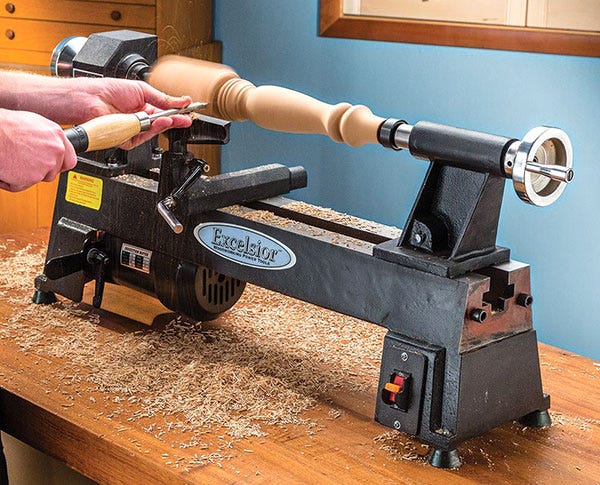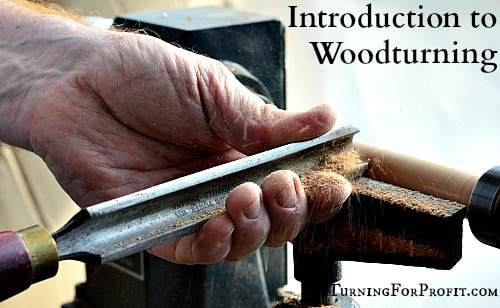If you’ve ever wondered about starting woodturning, you’re in the right place! So, what do you need to start woodturning? We’ve got you covered.
Whether you’re a young aspiring woodworker or just curious about this craft, we’ll break down the essential tools and materials you’ll need to get started.
From lathes to chisels and safety equipment, we’ll guide you through the basics and help you embark on your woodturning journey. Let’s dive in!
1. Wood lathe
2. Turning tools (gouge, skew, parting tool)
3. Drive center and live center
4. Faceplate or chuck
5. Sandpaper and finishing supplies
These tools will allow you to shape and form wood into beautiful turned objects. Remember to prioritize safety and practice proper technique as you embark on your woodturning journey!

What Do I Need to Start Woodturning?
Welcome to the exciting world of woodturning! If you’ve been captivated by the artistry and craftsmanship of turned wooden objects and want to try your hand at it, you’re in the right place. Woodturning is a rewarding and fulfilling hobby that allows you to unleash your creativity and create beautiful works of art from a simple piece of wood. But before you grab your tools and start turning, let’s explore what you need to get started on your woodturning journey.
Essential Woodturning Tools
Woodturning requires a specific set of tools designed to shape and carve wood while it spins on a lathe. Here are the essential tools you’ll need to embark on your woodturning adventures:
1. Lathe
The centerpiece of any woodturning workshop is the lathe itself. This machine holds the piece of wood securely and allows it to rotate while you shape it with your tools. When choosing a lathe, consider factors such as size, speed control, and durability.
A quality lathe will provide a sturdy base, smooth operation, and adjustable speed options to accommodate different types of turning projects. Look for a lathe with a motor of at least 1 horsepower, a swing capacity of at least 12 inches, and a minimum of 24 inches between centers.
Remember to also invest in good quality lathe accessories and attachments, such as chucks, faceplates, and tool rests, to enhance your woodturning experience.
2. Turning Tools
Woodturning requires a specific set of tools designed to shape and carve wood as it spins on the lathe. Here are the essential turning tools every woodturner should have:
- Gouges: These tools have curved blades and are used for roughing, shaping, and smoothing the wood.
- Parting Tools: Parting tools are used to cut the wood into separate pieces and create intricate designs.
- Skew Chisels: Skew chisels have flat blades and are ideal for creating precise cuts and finishes on the wood.
- Scrapers: Scrapers are used to remove excess wood and create smooth surfaces.
- Round-nose Scrapers: These tools are used for shaping concave surfaces such as bowls and goblets.
Investing in high-quality tools made from high-speed steel (HSS) or carbon steel is essential for achieving clean cuts and preventing tool failure. Keep your turning tools sharp and well-maintained for optimal performance.
3. Safety Equipment
Woodturning involves sharp tools and fast-spinning wood, so it’s crucial to prioritize safety. Here are some essential safety equipment and measures to consider:
- Safety Glasses: Protect your eyes from flying debris and wood chips by wearing safety glasses at all times.
- Dust Mask or Respirator: Wood dust can be hazardous to your respiratory system, so wear a dust mask or a respirator to prevent inhalation.
- Ear Protection: The noise generated by the lathe can be damaging to your hearing, so wear earplugs or earmuffs for adequate protection.
- Workshop Layout: Organize your workshop to ensure a clutter-free and safe working environment. Clear away any tripping hazards and ensure proper ventilation.
Always prioritize safety when woodturning and familiarize yourself with best practices for safe tool usage and workshop setup.
Selecting the Right Wood
When it comes to woodturning, the choice of wood can greatly impact the final result of your project. Each type of wood has its own unique characteristics, such as color, grain pattern, hardness, and workability. Here are some popular options for woodturning:
1. Hardwoods
Hardwoods such as maple, oak, cherry, and walnut are commonly used in woodturning due to their durability and rich, natural beauty. The tight grain of hardwoods allows for intricate detailing and smooth finishes.
It’s important to note that different hardwoods have different hardness levels, which can affect the ease of carving and the durability of the finished piece. Softer hardwoods like pine are more forgiving for beginners, while harder woods may require more experience and sharpening skills.
Explore different hardwoods and experiment with their unique properties to discover the ones that align with your artistic vision and preferred turning style.
2. Exotic Woods
If you’re looking to add an extra touch of elegance and uniqueness to your woodturning projects, consider using exotic woods. Exotic woods like ebony, rosewood, and padauk offer stunning colors, grain patterns, and chatoyance, making them highly sought after by woodturners.
Keep in mind that exotic woods can be more expensive and sometimes harder to source, but the results are often worth it. They can truly elevate your woodturning creations and make them stand out.
3. Softwoods
While hardwoods are more commonly used in woodturning, softwoods like pine, spruce, and cedar can also be suitable for certain projects. Softwoods are generally easier to work with, making them ideal for beginners or for larger-scale projects where sculpting details may not be the primary focus.
Softwoods can have a more rustic appeal and may be more affordable, making them a popular choice for woodturners who are practicing their skills or working on less intricate designs.
In summary, to start woodturning, you will need a lathe, turning tools, and essential safety equipment. It’s important to invest in high-quality tools and prioritize safety in your workshop. The choice of wood is also crucial, with hardwoods, exotic woods, and softwoods offering different characteristics and aesthetic options for your woodturning projects. Enjoy the journey of discovering the art of woodturning and let your creativity shine through your turned creations. Happy turning!
Key Takeaways: What Do I Need to Start Woodturning?
Woodturning is a fascinating craft that requires a few essential tools and materials to get started. Here are five key things you need:
- A wood lathe: This machine allows you to hold and rotate the wooden piece while you shape it.
- A set of woodturning tools: Essential tools include a roughing gouge, parting tool, skew chisel, and bowl gouge.
- A face shield and safety glasses: Protect your eyes and face from flying wood chips and debris.
- A sharpening system: Properly maintained and sharp tools are crucial for successful woodturning.
- Wood blanks: These are the raw wooden pieces that you will shape and transform into beautiful turned objects.
With these basic tools and materials, you’ll have everything you need to begin your woodturning journey!
Frequently Asked Questions
Interested in starting woodturning? Not sure where to begin? Here’s a list of commonly asked questions to help you get started on your woodturning journey!
1. How can I get started with woodturning?
To get started with woodturning, you’ll need a few essential tools and materials. First, you’ll need a lathe, which is the main machine used in woodturning. Additionally, you’ll need a set of turning tools, such as gouges and scrapers, which allow you to shape and carve the wood. Don’t forget to stock up on sandpaper, as a smooth finish is vital in woodturning. Lastly, you’ll need a variety of wood blanks to practice and create your projects.
It’s also a good idea to invest in some safety gear, such as a face shield and dust mask, to protect yourself while working with wood. Consider taking a woodturning class or watching online tutorials to learn proper techniques and gain inspiration for your projects. With these essentials in hand, you’ll be well-equipped to start your woodturning adventure!
2. What types of wood are suitable for woodturning?
When it comes to woodturning, you have a wide variety of wood species to choose from. Some popular choices for beginners include maple, birch, and oak. These woods are known for their durability and workability, making them great choices for beginners to practice with. As you gain more experience, you can venture into more exotic woods, such as ebony or rosewood.
Each wood species has its own unique characteristics and grain patterns, which can add visual interest to your turned projects. It’s essential to ensure the wood is dry and properly seasoned before turning, as wet or green wood can cause the project to warp or crack. Experiment with different types of wood to discover which ones you enjoy working with the most.
3. Can I start woodturning with a mini or midi lathe?
Absolutely! Many woodturners begin their journey with a mini or midi lathe. These smaller lathes are more affordable and require less space compared to full-sized lathes. While they have a smaller capacity for turning larger projects, they are excellent for practicing and getting comfortable with the basics of woodturning.
A mini or midi lathe will allow you to turn small bowls, pens, and other smaller projects. As you progress and gain more experience, you can always upgrade to a larger lathe if you feel the need. Starting with a mini or midi lathe is a fantastic way to dip your toes into woodturning without breaking the bank.
4. What safety precautions should I take when woodturning?
Safety should always be a top priority when woodturning. First and foremost, make sure you are wearing safety goggles or a face shield to protect your eyes from flying wood chips. It’s also crucial to wear ear protection, as lathes can create significant noise levels.
Additionally, use a dust mask or respirator to protect your lungs from the fine wood particles generated while turning. Always ensure your lathe is securely positioned and stable before starting your project. Keep your turning tools sharp to prevent accidents, and never wear loose clothing or jewelry that could get caught in the lathe. By following these safety precautions, you can enjoy woodturning while minimizing any potential risks.
5. Are there any resources available to help me learn more about woodturning?
Absolutely! There are numerous resources available to help you learn more about woodturning. Consider attending local woodturning club meetings or workshops, where you can connect with experienced turners who can provide guidance and advice. Many online forums and social media groups also exist, allowing you to interact with other woodturners and share your projects.
In addition, there are plenty of instructional books, DVDs, and online tutorials that can teach you various woodturning techniques. Watching videos from experienced woodturners can be particularly beneficial, as you can visually see the techniques in action. Don’t be afraid to experiment, ask questions, and seek advice from the woodturning community. Learning from others is a fantastic way to enhance your woodturning skills and broaden your knowledge in this rewarding craft.

Summary
So, to start woodturning, you’ll need a lathe, some turning tools, and safety gear. The lathe is the main machine used for shaping and spinning wood. Turning tools like gouges and chisels are used to cut and shape the wood. And don’t forget to wear safety gear like goggles and a face shield to protect yourself. Remember, always prioritize safety while having fun with woodturning!
In addition to the basic tools, having a workbench, good lighting, and a sharpening system will make your woodturning experience even better. A workbench provides a sturdy surface for your lathe and tools. Good lighting helps you see the details of your work, and a sharpening system keeps your tools in top shape. So, with the right tools and a focus on safety, you’re all set to start your woodturning journey!